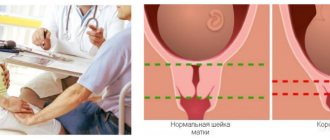- March 3, 2019
- Pregnancy
- Ekaterina Sobolevskaya
A normal birth that is ready to take place in a timely manner will never begin violently and suddenly. On the eve of this event, the expectant mother experiences their harbingers. The cervix begins to gradually prepare for an important process. All changes (water breaking, contractions starting) indicate that the baby will see the light very soon. How the uterus opens, what it actually is and what you need to be prepared for at this moment - in this article.
Stages of the birth process
Childbirth is the process of expulsion of the fetus and placenta from the uterus. If they take place in a standard manner, then everything happens naturally. In cases where doctors are forced to resort to different delivery methods using surgical intervention, childbirth is usually called operative. A woman needs to prepare in advance for what happens in the delivery room in order to be “armed” with knowledge. If she understands perfectly what will happen to her, how it will all happen, then giving birth will be easier.
Before you begin to understand how the cervix opens before childbirth, you need to know that childbirth consists of three stages. And each of them is very important for mother and baby. So these steps are as follows:
- dilation of the uterus (another name for it is dilation of the cervix);
- expulsion of the fetus;
- birth of placenta.
In terms of time period, the longest is the first period. It is then that, due to the fact that the uterus contracts, the amniotic sac forms, the baby passes through the birth canal. As a result, during childbirth, the cervix fully dilates and the baby is born.
Women giving birth for the first time experience this period for about twelve hours. For those who have had this not for the first time - a little less - about eight. Knowing exactly how many centimeters the dilation of the cervix will be during childbirth, you can accurately determine what phase of contractions is currently taking place.
https://youtu.be/ciYQPEZwzY4
Treatment
If the cervix does not dilate between 35 and 40 weeks, then they try to leave this condition without treatment. Perhaps, due to the characteristics of the body, the process will occur a little later. If at 40 weeks there are no signs that the uterus is dilating, then the problem arises of how to speed up the dilatation of the cervix. They take measures both non-medicinal (exercises that stimulate expansion) and medicinal (medicines, catheter, sticks). Women with type 2 diabetes mellitus and women in labor who have suffered severe gestosis are also treated. Insufficient opening threatens the development of early fetal hypoxia, and possibly asphyxia.
Non-drug treatment
Non-drug treatment includes exercise to stimulate cervical dilatation. They are the initial stage of treatment. You can do regular exercises that are enough in everyday life. Examples of exercises:
- Do cleaning, but very carefully, without heavy loads.
- Take a walk outside every day.
- Swimming is possible.
- Regular sex also stimulates the process of uterine dilatation. Because during sex, blood circulation in the uterus improves, and it has also been proven that semen contains substances that speed up labor.
If the fetus is full-term, you can try using a cleansing enema. The water in the enema, when it enters the intestine, stimulates the back wall of the uterus and causes dilation of the cervix.
Drug treatment
The main method of treatment is medication. You cannot prescribe medications for yourself. It is prescribed only by the attending physician, an obstetrician-gynecologist who is confident in the diagnosis of cervical immaturity and believes that it is already necessary for the woman to give birth. Main drugs and methods used:
- Preparations of prostaglandin, a hormone that stimulates the relaxation of smooth muscles. It promotes the opening of the uterine os. As a rule, gels with prostaglandins are used: Progestogel 1%. Injected into the vagina several times a day, constantly monitoring the dynamics of the condition. It is also possible to use prostaglandins intravenously. Also, a prostaglandin tablet can act as a stimulant.
- The labor hormone - oxytocin (solution or tablet), administered intramuscularly, also stimulates labor and acts faster than prostaglandins.
- Kelp sticks are used. The sticks are inserted into the vagina, into the uterine canal. These sticks contribute to its expansion purely mechanically (when the sticks come into contact with liquid, they swell in the channel). Sticks have proven effective but are rarely used.
- A Foley catheter, which is inserted into the cervical canal and expands it, also works mechanically. In addition, when a catheter is inserted, a significant amount of prostaglandins is produced. This method works faster than others.
Thus, for the normal course of pregnancy, timely and correct dilation of the uterus during childbirth is necessary. It is important to monitor her condition starting from the last weeks of pregnancy. Only a doctor can diagnose when it has not opened and prescribe appropriate treatment.
The cervix dilates
From about the thirty-second week of expecting a baby, the cervix begins to prepare for childbirth. And yet there is still a dense area of tissue near the cervical canal. And in other places, the cervix softens before childbirth. It all ends by the 38th week of expecting a baby. The future newborn has descended into the pelvis and with all its weight (although it may not be that big) puts some pressure on the cervix. This causes it to open up even more.
When the doctor tells a pregnant woman that she is one finger dilated, she begins to think about how long it will take to expect labor. But so far this situation only indicates that the body is physiologically prepared for childbirth. But they will begin when regular contractions appear. That is why dilation of only one finger will not tell you when labor will begin, but will indicate that the woman is ready to begin intensive labor.
Cervical immaturity
The cervix is called immature throughout pregnancy. Why immature? What signs determine? At this time, it is dense, elastic, and does not allow even 1 finger to pass through the pharynx. And its length is about two centimeters. If, starting from the 38th week of pregnancy, dilation does not occur, the cervix is considered immature, this is already a variant of the abnormal course of pregnancy, which is why it is important to diagnose this condition in time.
It is necessary to use additional methods to stimulate the disclosure process. The mature cervix before childbirth is softened, short and dilated to the required number of centimeters.
Causes of immaturity
Immaturity of the uterus means a condition in which it does not become soft, does not shorten, and does not open in due time. This prevents the onset of normal labor. It is determined to be approximately 39 weeks. Within 40 weeks, the pharynx should open sequentially by 1 finger, then by 2 fingers, and to the point where the palm can pass through. Why the expansion doesn't happen:
- Underdevelopment of the pelvic organs, congenital anomalies.
- Nervous disorders, feelings of anxiety.
- Insufficient production of estrogen hormones and oxytocin.
- Strong contractions, muscle spasms.
- Insufficient amount of amniotic fluid.
- The woman is over 35 years old.
Body readiness parameters
In addition to the fact that the opening of one finger has occurred and the neck has softened, it needs to be shortened - to a length of one centimeter. Now it is located in the center of the small pelvis, although some time ago it was deviated to the side.
During this period of pregnancy, there should be a discharge of the mucous plug, which protected the uterus during all the months of waiting for the baby. The fact that the plug has come away indicates that the cervix is ripe and contractions are about to begin. First, the internal os of the cervix opens, and when the fetus begins its journey through the birth canal, the external os also tends to stretch.
For those women who have already given birth before, this opening occurs simultaneously, so everything will take much less time than for those who give birth for the first time.
It is much more common for doctors to hear how many fingers should be dilated during childbirth, because they determine this based on their own fingers.
In some cases, it happens that labor has already begun, but the cervix is not at all ready and is not yet dilating. In this case, doctors may use stimulation because the fetus will not have enough oxygen due to the rapid aging of the placenta and its loss of ability to perform its basic functions.
Stages of dilatation during pregnancy and childbirth
It happens that for some reason the opening occurs earlier than the appointed time, and this can be fraught with the loss of the baby or premature birth.
Frequent causes of this pathological condition are:
- changes in hormonal levels;
- history of early abortions or miscarriages;
- previous injuries before pregnancy (surgery, removal of genital organs);
- previous births occurred with ruptures or complications (large fetus);
- inflammatory diseases (cysts or ulcers of the cervix).
The opening of the cervix begins with the external os. If a woman is primigravida, then the cervical canal looks like a cone with the base facing upward. For multiparous women, the picture changes slightly - the external os opens faster (by one finger). During labor, for the birth of a baby, the cervix must be dilated by 10 cm - that's about 5 fingers.
The first stage of labor is the period of dilation of the cervix up to 10 cm. The stages during which the dilation of the cervix occurs before pushing are divided:
- Initial period (latent). Short-term, weak contractions are observed. There is no particular discomfort or pain. During this period, the cervix dilates to 4 cm.
- Active phase of disclosure. During this period, it is not advisable to sit or lie down - this can cause weak contractions and further non-dilation of the cervix during childbirth. Therefore, doctors recommend staying in an upright position for as long as possible in order to speed up the process of expelling the baby. You can also use breathing exercises; you can learn more about them from your leading gynecologist. During this phase, the membranes most often rupture, which is associated with the woman’s readiness to give birth. The cervix dilates from 4 to 10 cm.
- Deceleration phase. Contractions become less active. During this period, the cervix dilates completely to 10 cm. In multiparous women, this phase may not be expressed.
Full dilatation of the cervix and the beginning of pushing marks the beginning of the second stage of labor. At this time, you need to constantly be near the woman, monitor her condition and the passage of the child through the birth canal.
Let's dwell on the terminology
How does the cervix dilate before childbirth? This process takes place without any symptoms. It can only be determined by a doctor when he performs a vaginal examination. In order to understand how far the process of softening, shortening and smoothing of the cervix is progressing, it is necessary to define obstetric terms.
Doctors often still today determine the opening of the uterine pharynx in the fingers (this was already mentioned just above). In other words, the number of fingers the pharynx can allow through is the same as its opening. The approximate width of the “obstetric finger” is two centimeters. But it is clear that everyone’s fingers are different, so it is considered most accurate when the opening is measured in centimeters, for example, the dilation of the cervix by 2 fingers.
Thus, if the cervix is dilated by one finger, then we are talking about an opening of 2-3 cm; if the opening of the pharynx has reached 3-4 cm, then it is said differently that the opening is two fingers. This is usually diagnosed when regular labor begins (at least three contractions in 10 minutes); Almost complete opening is indicated by the dilatation of the cervix by eight centimeters - or 4 fingers.
The doctor records full dilatation when the cervix is completely smoothed (its edges are thin) and there is patency of 10 cm - or 5 fingers (the head has dropped to the pelvic floor, turned into a straight size with an arrow-shaped suture, the woman has an irresistible desire to push - now it’s time to the delivery room in order for the long-awaited little one to be born - this is the beginning of the second stage of labor).
Stages of disclosure
In the dilation of the uterus, I distinguish several stages, characterized by different states of the cervix. Each stage is accompanied by its own sensations. The main stages are as follows:
- The first stage is characterized by slow dilation of the uterus, starting with dilation to one or two fingers during the week before birth, reaching dilation before birth 4–6 hours, but not more than 10 cm. The process is accompanied by regular contractions, but rare.
- At the second stage, dilation occurs at about 1 centimeter per hour, the cervical part expands to 10 cm or more, contractions occur every minute.
- The third stage is characterized by the complete completion of the opening process and full readiness for the birth of the fetus.
1 finger opening
The minimum width to which the uterus opens is 1 finger of the doctor conducting the examination. One finger is approximately 1.5–2 cm. This process occurs at 38 or 39 weeks of pregnancy, that is, it means the period of preparation for childbirth has begun. A woman may feel heaviness in the vaginal area, slight discomfort, nagging pain in the lower abdomen and lower back, which is why she consults a doctor. But 1 finger does not mean hospitalization in a hospital; you can stay at home in this condition.
2 finger opening
If dilatation is 2 fingers or more, hospitalization in the maternity ward is indicated; this means that the period of labor has begun. As a rule, cervical dilatation occurs around 40 weeks, accompanied by regular contractions and pain in the lower abdomen. The woman is admitted to the maternity ward and is regularly examined, monitoring the process of expansion of the pharynx to the size required for childbirth.
The main thing to remember is that if an opening of 2 centimeters occurs earlier than 38 weeks, this indicates premature birth, which is why it requires urgent measures.
What happens to the cervix before childbirth?
The doctor is required to examine the cervix before childbirth. This is done in the last weeks, when the expectant mother comes to the consultation each time. During all months of pregnancy, the cervix is long and hard, and the cervical canal is closed quite tightly - additional closure is carried out by a mucus plug. In the last weeks of expecting a baby, such an immature cervix is not the norm.
Its gradual changes begin approximately half a month before the due date. The neck gradually becomes more elastic and softer, its length is approximately halved. The opening of the uterus and softening of the cervix occurs in parallel with the release of the mucus plug, mucous discharge from the genital tract and contractions, which become harbingers. Little by little, the cervix turns forward due to the softening of the lower segment of the uterus. Now nothing can stop the baby from being born. When labor begins, the mature cervix will open with ease, its edges have now become elastic enough for the baby to appear successfully in this world.
Definition of maturity
The cervix can be either mature or vice versa. If an “immature” cervix is observed at the time of the upcoming birth, approximately 40 weeks, then doctors are forced to use artificial preparation for labor. In the ninth month of bearing a baby, the placenta exhausts its functional strength, which can lead to oxygen starvation of the baby. If the cervix is mature, then there is nothing to worry about.
Many women in labor are interested in how to speed up the dilatation of the cervix and whether this is dangerous for the baby’s life? There are various medicinal and folk methods in which the cervix is able to open at the right time.
If the cervix does not dilate during childbirth, the following methods are used:
- Independent (folk):
- Using a cleansing enema helps open the cervix (use only if the baby is full-term). Careless actions threaten placental abruption, bleeding and fetal death.
- Regular sex in the last weeks of pregnancy. A man's sperm contains substances (prostaglandins) that accelerate labor. You should not have sexual intercourse when the mucous plug has passed (there is a high risk of infection in the uterus), with placenta previa and a high risk of bleeding.
- Gymnastic exercises with the doctor’s permission, as well as to stimulate the uterus: long walks in the fresh air, light physical activity.
- With a doctor's prescription (using medications):
- Prepidil-gel is injected into the cervical canal. After which, after 6-12 hours, the cervix dilates.
- Injection of kelp sticks (seaweed) into the cervix. The procedure is carried out by a gynecologist: he moves sticks 5-6 cm long into the cervical canal. After a couple of hours, they gradually swell under the influence of moisture and thereby contribute to the mechanical opening of the canal. After about a day, the cervix dilates by 2 fingers.
- Prescription of Mifepristone and other drugs that stimulate uterine contractility and the initiation of labor.
Attention! Before using one of these traditional methods, you must consult a leading doctor.
Who may be included in the risk group?
The readiness of the cervix is very important if the expectant mother has factors that can lead to pathology during childbirth. A fairly serious attitude is required if:
- the onset of previous labor was also with an immature cervix and with labor disturbances;
- during a previous pregnancy, there was a late delivery date or the current pregnancy is post-term;
- there was erosion, during which the cervix was cauterized, or other operations were performed in the cervical area: now there is a risk of scarring;
- the date of birth needs to be brought forward due to the health status of the expectant mother or fetus;
- the pregnant woman has already begun labor, but the cervix is not yet prepared;
- During previous births, the woman had a Caesarean section.
In any of these cases, doctors decide on medical intervention in the birth process. Quite often - to save both the baby and the mother.
Dilatation of the cervix by 1 finger: when to give birth?
Many representatives of the fairer sex who are preparing to become mothers hear a similar diagnosis. What does it mean?
Gynecologists and obstetricians always measure the dilation of the cervical canal in their fingers. Full opening of the reproductive organ creates a hole of 10 centimeters. One finger is equal to approximately two centimeters. If you have the position of the cervix described above, then you can assume that the opening in the cervical canal has reached approximately 2 cm. When can you expect the onset of labor? It all depends on the woman’s body. Let's look at a few popular situations.
In up to 15 percent of conizations, tissue changes extend to the edge of the removed tissue cone. Doctors call this "positive refusal." In this case, there is a certain risk that there is still tissue on the cervix. Therefore, more frequent and intensive follow-up examinations are important. This means that in addition to tampons, surveillance colposcopy should be performed every three to four months. If all examinations are undetectable over the next 12-18 months, regular smears once a year are sufficient.
This question can be clarified with the help of cell samples that the doctor takes from the smear. Ask your veterinarian if the test is useful and when the health insurance company will reimburse the cost. Women aged 18 and older, as well as boys and men, are likely to benefit from vaccination. However, they usually must pay for the vaccination themselves.
Labor will begin in a few hours
If the expectant mother has a one-centimeter dilatation of the cervical canal, then labor may well begin within a few hours. In this case, the position of the cervix must also be taken into account. It should be straight. It is also necessary to determine the length of the cervical canal. This distance does not exceed one centimeter. If these indicators are distinctive, then, most likely, the woman is not yet fully ready for the birth of a baby.
There are a few weeks left before the birth
How to determine cervical dilatation? Very simple. This can be done by an obstetrician or gynecologist during a routine examination. When the cervical canal expands to one finger, a woman may well have several more months before giving birth. Often in multiparous women, such indicators are detected already at the 32nd week of pregnancy. However, representatives of the fairer sex safely carry the baby to term for the required 40 weeks.
If during such dilation there are no contractions, pain or bleeding from the vagina, then the woman is usually sent home. However, if the due date has already approached, and the cervix is still not ready, then doctors perform stimulation. It consists in the introduction of certain medications that contribute to the rapid expansion of the cervical canal and the onset of contractions.
Diagnosis: immature cervix
Doctors use a similar term when labor is about to begin, but the cervix is still long and hard, the cervical canal is still closed, the cervix is wrapped as before and has not yet turned along the wire axis of the pregnant woman’s pelvis.
All this is a huge obstacle during childbirth. Stimulating the birth process if the uterus is immature is completely useless: the contractions needed at the moment will still not happen, the pregnant woman will begin to suffer, and labor will last more than a day. And yet, it’s unlikely that everything will work out on its own, without medical help.
It will also be quite difficult for the little one: he will not have enough oxygen, and besides, he may get injured, as well as his mother. Nature has invented the structure of a woman’s body - even if the cervix is not yet properly opened, the uterus will continue its contractions until the cervix or uterine wall ruptures during childbirth. The baby strives to be born, and it will be born, one way or another.
Necessary measures
Preparing the cervix for childbirth is truly a necessity. Especially if the expectant mother is overdue. How to prepare the cervix for childbirth? There are methods by which this can be done - medical and folk. Indeed, there are various folk methods that describe methods of preparation at home without the use of drugs. But you should not use at least one of the options without consulting a doctor in advance, because most of them are dangerous and can harm the baby.
Medical methods. Laminaria and chairside examination
In order for the cervix to ripen as quickly as possible and the uterus to open, the gynecologist introduces kelp into its canal - thin (thick as a match) sticks that can expand tens of times when exposed to moisture. They are made from seaweed. They are administered to the expectant mother on a gynecological chair. The procedure itself is quite unpleasant and can cause pain, but the next couple of days will be even more interesting. Laminaria, increasing in volume, will constantly exert increasing pressure on the neck, swelling in its canal. And the cervix, in turn, will quickly soften and ripen, which will be accompanied by training contractions, pain in the lower abdomen and mucous discharge.
The dilatation of the cervix will accelerate when the woman is examined by a gynecologist on the chair. You can hear from some mothers that after this procedure, when the patency of the cervical canal is checked, their mucous plug comes off and the process of preparing for childbirth is accelerated.
Methods of medicine. Antispasmodics and prostaglandins
Before the birth process begins, a hard cervix can soften if the doctor uses antispasmodics and beta-blockers. But medical workers use treatment with tablets and injections much less often.
A quick, albeit painful, discovery also occurs after using a gel that contains prostaglandins. It should be inserted into the cervical canal, which will quickly soften. In this case, training contractions and precursors intensify - the pregnant woman quickly gets tired.
Folk methods. Good old sex
How to prepare the cervix for childbirth without using any medications?
Having sex before giving birth will help dilate your cervix. Moreover, both due to mechanical stimulation and due to the fact that male sperm contains a large amount of prostaglandins. By the way, orgasm itself, when a woman is fully ready, can provoke labor.
Another option is to increase physical activity. A woman can walk up the stairs, clean the house while squatting, and the like. This method will not work if there is a pregnancy pathology.
The ripening of grass necks will help - rose hips, hawthorn, raspberry and strawberry leaves, evening primrose oil. And here there are some restrictions: the expectant mother may have an allergy or intolerance to herbs, unexpected reactions of the body. Therefore, first of all, you need to consult a gynecologist and under no circumstances self-medicate.
Causes
Premature dilatation of the cervix in early pregnancy often results in miscarriages. Softening provokes expansion, opening. It is difficult for the fetus to hold on.
There are 2 types of ICN:
- organic;
- functional.
What a particular woman will have will be determined by the reasons that formed her. Organic is also called traumatic because it is caused by injury. The cervix loses its elasticity and becomes scarred.
Causes:
- abortions;
- miscarriages;
- cervical injuries;
- treatment of polyps, erosion;
- scraping.
Scar tissue cannot stretch. It is made up of connective fibers. They are characterized by increased rigidity. The ability to contractility is lost. As a result, the baby is not held inside. The ICN appears.
Functional call:
- changes in hormones;
- polyhydramnios;
- pathologies of the reproductive organ;
- imbalance of tissues.
A large amount of androgen produced or a small amount of progesterone leads to hormone disruption. The consequence is detected at the 11th week of pregnancy. The cervix weakens and opens.
Large accumulation of water is also considered a serious cause. This phenomenon is observed during multiple pregnancies. The load on the reproductive organ increases, and insufficiency occurs.
These reasons contribute to varying degrees of softening. The uterus prepares for childbirth ahead of time and becomes pliable. As the baby grows, the ability to stay inside decreases. Functional failure affects women who have problems with the functioning of the ovaries. Congenital ICI is also sometimes present.
Each woman experiences this disease individually. Instead of one reason, it can be caused by two or more. In any case, it is difficult for the child to hold on, he heads towards the exit. As it goes down, the pressure increases. Low position leads to infection. As a result, a miscarriage or premature labor occurs.
Unpleasant “surprise” after childbirth
A similar disease as cervical erosion after childbirth occurs in those women whose birth of a long-awaited baby was accompanied by complications. If the cervix is very difficult to open during childbirth, this will greatly increase the risk of internal tissue rupture. If the doctor did not notice them in time or applied the sutures carelessly, erosion will almost always occur in this case.
What is cervical erosion after childbirth? The cervix is an extension of the uterus itself, a kind of “canal” that connects the uterine cavity and the vagina. During examination, the gynecologist can see only its vaginal part (exocervix), but the internal part (endocervix or cervical canal) is not available for examination. When the endocervix becomes visible, the doctor says that the patient has cervical erosion.
The provocateurs of the disease are: frequent abortions in the past, early or late births, rapid or rapid labor, significant fetal size. Various infectious diseases that can be transmitted through unprotected sexual contact can also lead to the disease.
Childbirth: step-by-step instructions
le> Having an understanding of what is happening during each stage of the process will help a woman have an easier time experiencing childbirth and actively participate in it.
We will try to give a consistent description of what physiological processes occur during childbirth, what a woman feels at this time, and what medical procedures can be carried out during different periods of labor.
Childbirth is the process of expulsion of the fetus from the uterine cavity, its immediate birth and the release of the placenta and membranes. There are three periods of labor: the period of opening, the period of expulsion and the afterbirth period.
Cervical dilatation
During this period, a gradual expansion of the cervical canal occurs, that is, the opening of the cervix. As a result, an opening of sufficient diameter is formed through which the fetus can penetrate from the uterine cavity into the birth canal formed by the bones and soft tissues of the small pelvis.
The opening of the cervix occurs due to the fact that the uterus begins to contract, and due to these contractions the lower part of the uterus, i.e. its lower segment stretches and becomes thinner. Dilation is conventionally measured in centimeters and determined during a special obstetric vaginal examination. As the degree of dilatation of the cervix increases, muscle contractions intensify, become longer and more frequent. These contractions are contractions - painful sensations in the lower abdomen or lumbar region that the woman in labor feels.
The first stage of labor begins with the appearance of regular contractions, which gradually become more intense, frequent and prolonged. Typically, the cervix begins to dilate with the onset of contractions that last 15–20 seconds and are spaced 15–20 minutes apart.
During the first stage of labor, there are two phases - latent and active.
The latent phase continues until approximately 4–5 cm of dilation; during this phase, labor is not intense enough, contractions are not painful.
The active phase of the first stage of labor begins after 5 cm of dilation and continues until full dilation, that is, up to 10 cm. At this stage, contractions become frequent, and pain becomes more intense and pronounced.
In addition to uterine contractions, an important part of the first stage of labor is the release of amniotic fluid. The time of discharge of water in relation to the degree of dilatation of the cervix is of great importance, as this can affect the course of the labor process.
Normally, amniotic fluid flows out during the active phase of labor, since due to intense uterine contractions, the pressure on the amniotic sac increases and it opens. Usually, after opening the amniotic sac, labor intensifies and contractions become more frequent and painful. When the amniotic fluid ruptures before the cervix is dilated by 5 cm, they speak of early rupture. It is most favorable if the outpouring of water occurs after the dilation has reached 5 cm. The fact is that at the beginning of labor, before the cervix is dilated by 5 cm, there is an increased risk of developing weakness of labor, that is, a weakening of contractions or their complete cessation. As a result, the course of labor slows down and may drag on indefinitely. If the amniotic fluid has already poured out, then the fetus is not isolated and not protected by the amniotic sac and amniotic fluid. In this case, the risk of developing intrauterine infection increases. To avoid intrauterine infection, labor should be completed within 12–14 hours from the moment of rupture of amniotic fluid.
If the waters break before regular labor begins and the cervix begins to dilate, they speak of premature rupture of water.
How to behave
If you experience regular painful or pulling sensations in your lower abdomen, begin to note the start and end times of these sensations, as well as their duration. If they do not stop within 1–2 hours, last approximately 15 seconds every 20 minutes and gradually intensify, this indicates that the cervix has begun to gradually open, that is, the first stage of labor has begun and you can get ready for the maternity hospital. At the same time, there is no need to rush - you can observe your condition for 2-3 hours and go to the maternity hospital with more or less intense labor, that is, with contractions every 7-10 minutes.
If your amniotic fluid has broken, then it is better not to delay the trip to the maternity hospital, regardless of whether contractions appear or not, since premature or early rupture of amniotic fluid can affect the choice of labor management tactics.
In addition, remember the time when regular contractions began, and also record when the amniotic fluid was released. Place a clean diaper between your legs so that the emergency room doctor can assess the amount of water and their nature, which can be used to indirectly assess the condition of the unborn baby. If the waters have a greenish tint, this means that original feces - meconium - have entered the amniotic fluid. This may indicate fetal hypoxia, that is, that the baby is experiencing a lack of oxygen. If the waters have a yellowish tint, this may indirectly indicate a Rh conflict. Therefore, even if the water leaks just a little or, on the contrary, pours out in large quantities, you should save the diaper or cotton pad with the leaked amniotic fluid.
To relieve pain during uterine contractions, try to take deep breaths through your nose and exhale slowly through your mouth during contractions. During contractions, you should behave actively, try not to lie down, but, on the contrary, move more, walk around the ward.
During a contraction, try different positions that make the pain easier to bear, such as resting your hands on the bed and leaning slightly forward with your feet shoulder-width apart. If your husband is present at the birth, you can lean on him or squat down, and ask your husband to support you.
A fitball, a special large inflatable ball, will help ease the sensations during contractions.
If possible, contractions can be endured in the shower, directing a warm stream of water to the stomach, or immerse yourself in a warm bath.
What does a doctor do?
During the first stage of labor, special obstetric manipulations are required from time to time to help choose the right tactics for labor and assess the risk of possible complications.
An external obstetric examination is performed upon admission of the expectant mother to the maternity hospital. During this procedure, the approximate weight of the fetus is assessed, the external dimensions of the expectant mother's pelvis are measured, the location of the fetus, the standing height of the presenting part are determined, that is, at what level in the birth canal is the presenting part of the fetus - the head or buttocks.
During a vaginal examination, the condition of the cervix, the degree of its dilation, and the integrity of the amniotic sac are assessed. The presenting part is determined: the head, legs or buttocks of the fetus - and the nature of its insertion, that is, which part - the back of the head, forehead or face - the head was inserted into the small pelvis. The nature of the amniotic fluid, its color and quantity are also assessed.
During the normal course of the first stage of labor, a vaginal examination is performed every 4 hours to assess the dynamics of cervical dilatation. If complications occur, this study may need to be performed more frequently.
Every hour during the dilatation period, the mother's blood pressure is measured and auscultation is performed - listening to the fetal heartbeat. It is performed before contraction, during contraction and after it - this is necessary in order to assess how the unborn baby reacts to uterine contractions.
To more accurately assess the nature of the fetal heartbeat and indirectly study its condition during childbirth, each woman in labor undergoes a cardiotocographic study - CTG. Two sensors are installed on the surface of the uterus, one of them records the fetal heart rate, and the other - the frequency and intensity of uterine contractions.
The result is two parallel curves, after studying which the obstetrician-gynecologist can objectively assess the well-being of the unborn baby, notice signs of possible complications in time and take measures to prevent them. During normal labor, CTG is performed once and lasts for 20–30 minutes. If necessary, this study is performed more often; Sometimes, when the birth is high-risk, a continuous recording of a cardiotocogram is performed. This happens, for example, if there is a postoperative scar on the uterus or with gestosis - a complication of pregnancy, which is manifested by high blood pressure, swelling and the appearance of protein in the urine.
Period of expulsion of the fetus
After the cervix has fully dilated, the second stage of labor begins, that is, the expulsion of the fetus from the uterine cavity, its passage through the birth canal and, ultimately, its birth. This period lasts for primiparous women from 40 minutes to 2 hours, and for multiparous women it can end in 15–30 minutes.
After leaving the uterine cavity, the presenting part of the fetus, most often the head, performing certain rotational movements with its smallest size, gradually descends to the pelvic floor with each contraction and emerges from the genital slit. After this, the birth of the head occurs, then the shoulders, and finally the baby is born entirely.
During the expulsion period, uterine contractions are called pushing. This is due to the fact that, descending to the pelvic floor, the fetus exerts significant pressure on nearby organs, including the rectum, as a result of which the woman has an involuntary strong desire to push.
How to behave?
The second stage of labor requires a lot of energy expenditure from both the expectant mother and the fetus, as well as the well-coordinated work of the woman in labor and the obstetrics-gynecology team. Therefore, in order to make the course of this period as easy as possible and avoid various complications, you should listen carefully to what the doctor or midwife says and try to follow their advice exactly.
During the second stage of labor, obstetric tactics are largely determined by the level at which the presenting part of the fetus is located. Depending on this, you may be advised to push as hard as you can, or, conversely, try to hold back.
The desire to push may be accompanied by unpleasant pain. However, if pushing is not recommended at this time, every effort should be made to restrain the pushing, as otherwise cervical rupture may occur. The doctor may ask you to “breathe” through the pushing. In this case, you need to take frequent sharp breaths and exhales through your mouth - this is called breathing “doggy”. This breathing technique will help you control the urge to push.
If you are already in the delivery chair and your baby is about to be born, you will be asked to push as hard as possible while pushing. At this moment, you should concentrate as much as possible on what the midwife says, since she sees what stage the fetus is at and knows what needs to be done to facilitate its birth.
When you start pushing, you should take a deep breath and start pushing, trying to push the baby out. Typically, you may be asked to push 2-3 times during one push. Try not to scream or release air under any circumstances, as this will only weaken the pushing and it will be ineffective. Between attempts you should lie quietly, try to even out your breathing and rest before the next attempt. When the fetal head erupts, i.e. is established in the genital slit, the midwife may ask you not to push again, since the force of uterine contraction is already sufficient for further advancement of the head and its removal as carefully as possible.
What does a doctor do?
During the expulsion period, the mother and fetus are exposed to maximum stress. Therefore, monitoring the condition of both mother and baby is carried out throughout the entire second stage of labor.
The mother's blood pressure is measured every half hour. Listening to the fetal heartbeat is carried out with each push, both during uterine contractions and after it, to assess how the baby reacts to the push.
External obstetric examination is also regularly performed to determine where the presenting part is located. If necessary, a vaginal examination is performed.
When the head erupts, it is possible to perform an episiotomy - a surgical dissection of the perineum, which is used to shorten and facilitate the birth of the head. When giving birth in a breech position, an episiotomy is mandatory. The decision to use an episiotomy is made in cases where there is a threat of perineal rupture. After all, an incision made by a surgical instrument is easier to stitch up, and it heals faster than a lacerated wound with crushed edges due to a spontaneous rupture of the perineum. In addition, an episiotomy is performed when the condition of the fetus worsens in order to speed up its birth and, if necessary, immediately carry out resuscitation measures.
After birth, the baby is placed on the mother's stomach to provide first skin-to-skin contact. The doctor evaluates the condition of the newborn using special criteria - the Apgar scale. In this case, indicators such as heartbeat, breathing, skin color, reflexes and muscle tone of the newborn at 1 and 5 minutes after birth are assessed on a ten-point scale.
Succession period
During the third stage of labor, the placenta, the remainder of the umbilical cord, and the membranes are separated and released. This should happen within 30–40 minutes after the baby is born. In order for the placenta to separate, weak uterine contractions appear after childbirth, due to which the placenta gradually separates from the wall of the uterus. Once separated, the placenta is born; from this moment it is considered that childbirth is over and the postpartum period begins.
How to behave and what does the doctor do?
This period is the shortest and most painless, and practically no effort is required from the postpartum woman. The midwife monitors whether the placenta has separated. To do this, she may ask you to push slightly. If the remainder of the umbilical cord is retracted back into the vagina, then the placenta has not yet separated from the placental site. And if the umbilical cord remains in the same position, the placenta has separated. The midwife will again ask you to push and gently pull the umbilical cord to bring the placenta out.
After this, a thorough examination of the placenta and fetal membranes is performed. If there is any suspicion or indication that part of the placenta or membranes remains in the uterine cavity, a manual examination of the uterine cavity should be performed to remove any remaining parts of the placenta. This is necessary to prevent the development of postpartum hemorrhage and infection. Under intravenous anesthesia, the doctor inserts his hand into the uterine cavity, carefully examines its walls from the inside and, if retained lobes of the placenta or membranes are detected, removes them out. If spontaneous separation of the placenta does not occur within 30–40 minutes, this manipulation is performed manually under intravenous anesthesia.
After childbirth
After the birth of the placenta, a thorough examination of the soft tissues of the birth canal and perineum is performed. If ruptures of the cervix or vagina are detected, they are sutured, as well as surgical restoration of the perineum if an episiotomy has been performed or ruptures have occurred.
Surgical correction is performed under local anesthesia; in case of significant damage, intravenous anesthesia may be required. Urine is released through a catheter so that the postpartum woman does not have to worry about a full bladder for the next few hours. Then, in order to prevent postpartum bleeding, women place a special bag of ice on the lower abdomen, which remains there for 30–40 minutes.
While doctors examine the mother, the midwife and pediatrician perform the first toilet of the newborn, measure his height and weight, head and chest circumference, and treat the umbilical wound.
Then the baby is placed on the mother's breast, and for 2 hours after birth they remain in the maternity ward, where doctors monitor the woman's condition. Blood pressure and pulse are monitored, uterine contractions and the nature of vaginal bleeding are assessed. This is necessary so that if postpartum hemorrhage occurs, the necessary full assistance can be provided in a timely manner.
If the condition of the mother and the newborn is satisfactory, 2 hours after birth they are transferred to the postpartum ward.








